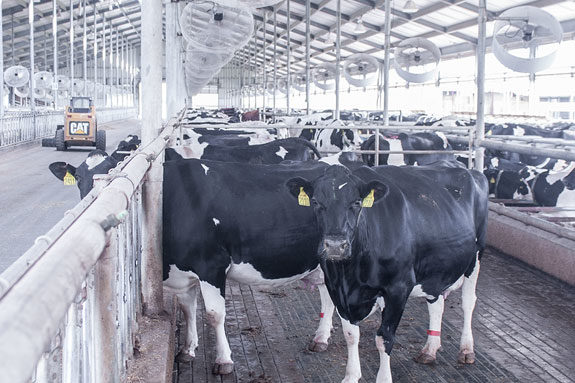Editor's note: South Dakota State University's Alvaro Garcia sent out the following information to the DAIRY-L list serv on Monday, May 13, 2013. This was sent as a heads-up for producers in the upper Midwest about temperatures for May 14. The heat that day and the following was preceded by unusually cool days and nights, and cows did not have the chance to acclimate.
In fact, in eastern South Dakota, there was a change of more than 90 degrees in just a couple of days. Cattle usually need two to four weeks of gradual temperature build-up to adapt to changes.
Body temperature regulation in dairy cows is constantly challenged by a combination of environmental heat and the heat produced during rumen fermentation and nutrient metabolism. Heat stress occurs when cows cannot dissipate enough heat to maintain their core body temperature below 101.3°F.
Air velocity also increases the maximum threshold, suggesting cows housed in facilities with forced air can tolerate higher ambient body temperature; when temperatures exceed 75°F, intake drops considerably even at 50 percent relative humidity.
Close-up and early lactation cows are the most sensitive to heat stress and need more stringent cooling strategies. One strategy is soaking them with water. Heat losses through the skin can be improved when both skin and coat are soaked.
Cows can tolerate greater body temperature during the day when ambient body temperature during the night drop below 70°F. Keep soaking them in the evening to help accomplish this. Intake and production are more closely associated with the temperature of the two previous days than those of the present one.
Whenever necessary, it is important to have strategies that reduce temperature at night. In fact, we are lucky temperatures this week will drop under 60. Even still, be on the lookout for signs of heat stress.
In order for soaking to be effective, soak coat and skin, and do it intermittently to allow time for water to evaporate before the next soaking cycle. For cows under severe heat stress, using sprinklers or fans alone is not enough. Both strategies need to be combined.
The effectiveness of the cooling system depends on the number of rows of cubicles: four rows, then the sprinklers over the feed bunk and two rows of fans, one over the cubicles, one over the feed bunk. If working with two rows, then one row of sprinklers over the feed bunk and one of fans over the cubicles.
High-pressure misters reduce the amount of water used but eject very small droplets and are incapable of soaking completely the coat and skin.
They create an air space between the skin and the water film, which insulates and impairs heat dissipation. To achieve cooling, they must work with a minimum water flow of 3.4 gallons per hour with five-minute cycles.
If temperature is 86 degrees and above, the soaking cycle frequency needs to be every eight minutes (one minute on, seven minutes off). When body temperature exceeds 68 degrees, the fans should work continuously.
Clean and fresh water, enough shade and adequate air circulation is critical to maintain production. These systems should be accompanied with key nutritional management strategies suggested for hot weather.
For more information on keeping dairy cows cool, visit http://igrow.org/livestock/dairy. PD
PHOTO
Cows cool off under the fans at Dykstra Dairy in Iowa. Photo by PD Editor Walt Cooley.

Alvaro Garcia
Extension Dairy Specialist
South Dakota State University







